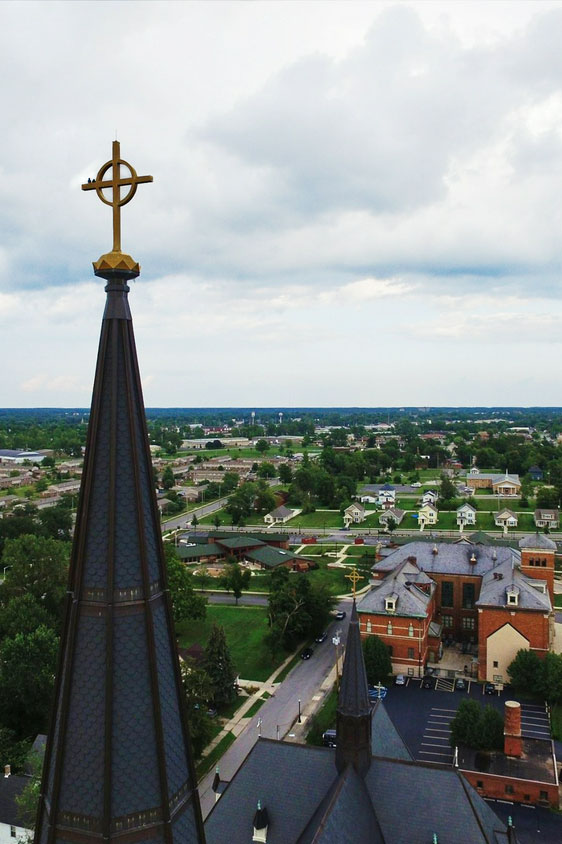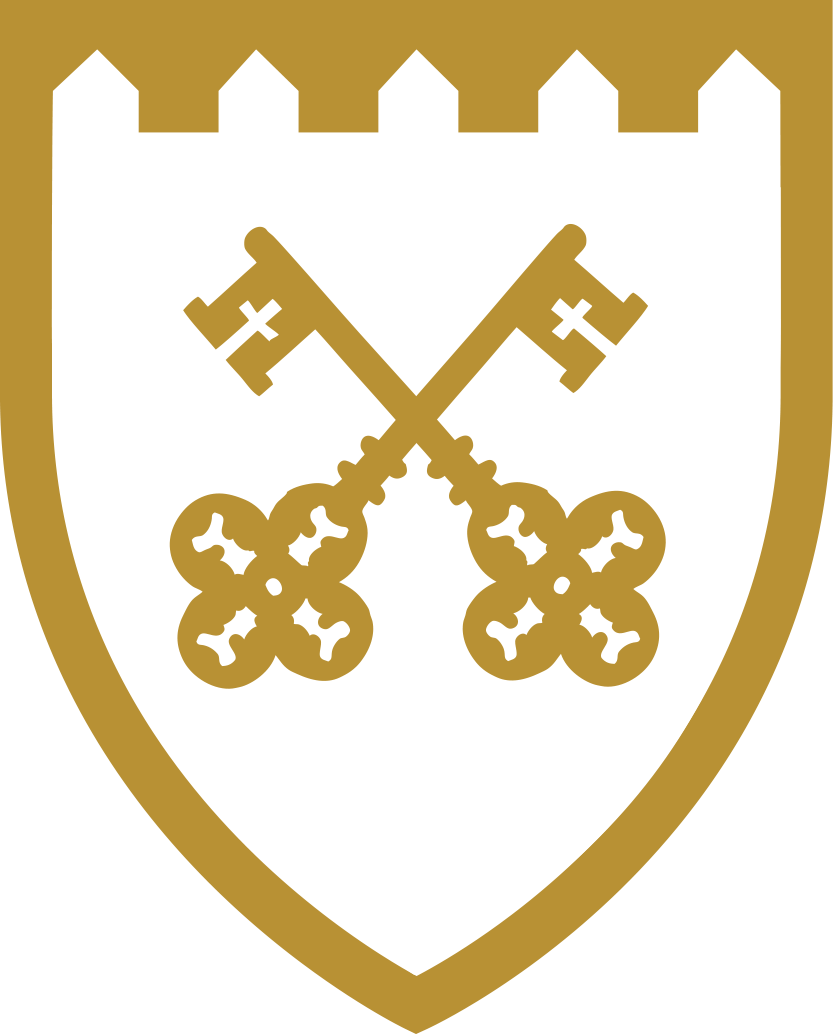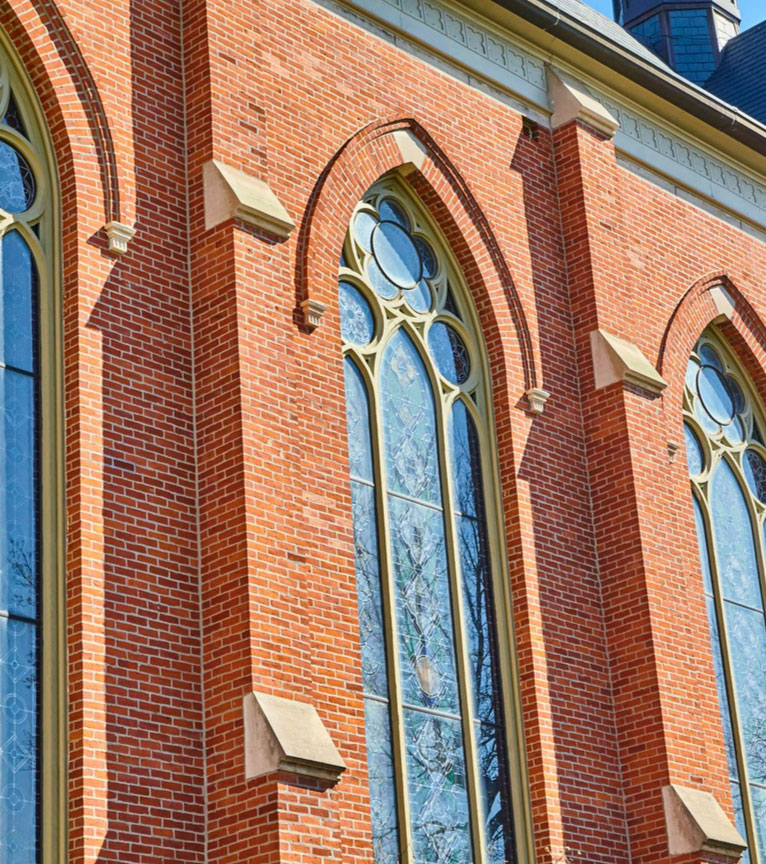OUR HISTORY


Established in
Fort Wayne in 1872
This Parish Church belongs to the greatest Christian Organization in the world, having a total membership in excess of one billion souls. The Faith taught here is the exact same Faith as was taught in all churches throughout the world prior to the “reformation.”
In this Parish Church, you, other visitors and devout adorers are not alone, for in the Tabernacle, in the center of the High Altar, Jesus Christ, the Son of God, the second person of the Most Holy Trinity, dwells as surely as He did in the Stable of Bethlehem and as He hung on the Cross on Mount Calvary. On this account, Catholics genuflect before the Tabernacle and attempt to maintain a reverential silence in this House of Worship. You are requested therefore, to conduct yourself with all propriety in this Church, which is God’s House.
If you desire any information about our Holy Faith, we are at your service.
THE BEGINNING
The years following the American Civil War saw a great increase in the numbers of peoples moving away from the central section of the city of Fort Wayne. One of the areas that saw the greatest influx was the immediate southeast area. By the early 1870s, it was evident that a new parish was needed to serve the predominantly German and French speaking peoples. In fact, this particular area was known respectively as “Germantown” and “Frenchtown.” In the summer of 1871, a group of Catholics assembled for just this purpose. The initial meeting, chaired by Peter Mettler, who for many years had shown great interest in just such a project, unanimously decided to approach Bishop Joseph Dwenger to receive the necessary Episcopal approval. The approval was immediate in coming, and it was decided to name the new parish, the city’s fourth parish and third German speaking parish, Saint Peter’s. In making this choice, the new parish would be placed directly under the protection of the Prince of the Apostles and the first pope, but also would honor, in an indirect manner, Peter Mettler, who for so many years led the crusade to have this parish established.
Father John Wemhoff was appointed by Bishop Dwenger as Saint Peter’s first pastor. Born in Minster, Germany, in 1837, he had come to America in 1858 and been ordained to the holy priesthood by the Diocese’s first Bishop, John Henry Luers in 1862. Fr. Wemhoff immediately set to work on procuring land for the newly formed parish. Eventually, enough property was purchased in what was known as the LaSalle Addition for the parish to have an entire city block, which became known as Saint Peter’s Square.
The first structure was erected in the middle of the block facing St. Martin Street and was a brick combination, two-story building intended to serve as both a church and a school. The first floor provided for four large classrooms, while the second floor was used as a church, which could easily hold 300 people. This structure was dedicated on December 27, 1872. In the same year, Fr. Wemhoff had built the first rectory at 2001 South Hanna Street. Unfortunately, the pastorate of Fr. Wemhoff did not last long. He died suddenly on December 1, 1880, and is buried in Fort Wayne’s Catholic Cemetery.
Father Anthony Messmann was immediately appointed as the second pastor of St. Peter’s by Bishop Dwenger. He, like Fr. Wemhoff, was a native of Germany, having been born there in 1839. He came to America at the age of 20 and was ordained to the holy priesthood by Bishop Luers in 1870. Fr. Messmann’s first efforts were focused on liquidating the parish debt, which he was soon able to accomplish. He succeeded in bringing the School Sisters of Notre Dame of Milwaukee, Wisconsin, to teach in the parish school. He built a new convent for the Sisters and also a new rectory.
Fr. Messmann served St. Peter’s as its pastor for some sixteen years. During that time he accomplished much in materially, as well as spiritually. However, unquestionably, his most outstanding achievement was the building of the new and present church. Construction began in 1892 and was completed the following year. The plans for the church were drawn by architect Peter Diedrich (1856-1924) of Detroit, Michigan, and the building contract was let to John Suelzer, Sr. (1852-1932), parishioner and builder of not only St. Peter’s, but also its current rectory, which served as the Suelzer Homestead from 1911 to 1949. Mr. Suelzer also built the majestic St. Mary’s Catholic Church, which was destroyed by fire in 1993. St. Peter’s new church was dedicated by Bishop Joseph Rademacher on November 4, 1894. Gothic in style, it measures 190 ft. x 80 ft. and is surmounted by a steeple towering over 200 ft. To this day, architects and building experts, as well as ordinary people, marvel at its structure and beauty. Even more marvelous was its cost: built and furnished at a total expense of $75,000. In July of 1896, Fr. Messman was transferred to St. Joseph’s Parish in LaPorte, Indiana, where he continued to serve the people of God until his death on May 22, 1912.

Bishop Rademacher appointed Father Ferdinand Koerdt as the successor to Fr. Messmann, making him St. Peter’s third pastor. Like the first two pastors, Fr. Koerdt was born in Germany in 1853 and came to America in 1875. One year later he was ordained a priest by Bishop Dwenger. Fr. Koerdt immediately turned his attention toward education and the building of a new and larger school, which he directed and supervised. Much to his regret, he was able to complete only one wing of his proposed school, the St. Martin Street wing, built in 1904 at the cost of $18,000. Early in 1905, because of failing health, Fr. Koerdt asked the Bishop to give him a temporary leave of absence. This request was granted and Fr. Koerdt went to Los Angeles, California, where he died on May 7, 1905 at the age of fifty-two.
On the patronal feast day of the parish, June 29, 1905, Father Charles H. Thiele began his duties as St. Peter’s fourth pastor. Like his predecessors, Fr. Thiele was born in Germany, and in 1862 came to America at the age of three. He was ordained by Bishop Dwenger in 1888. From 1905 until his death in 1941, Fr. Thiele worked tirelessly for St. Peter’s and its people. His accomplishments were many. He worked with the City of Fort Wayne to have the streets surrounding St. Peter’s extended and improved. He installed a central heating plant for all the parish buildings. He enlarged the convent and completed Fr. Koerdt’s original plans for the school. His greatest accomplishment was inside St. Peter’s Church. Exteriorly the church was an architectural gem, but inside much work was needed. Fr. Thiele had the entire interior frescoed. He had the hand-painted Stations of the Cross put in, and in the same year, 1908, he had the three beautifully illuminated altars installed. The altars were designed and built by the Emil Hackner Company of LaCrosse, Wisconsin, for a total cost of $8,000.00.
Fr. Thiele was also fond of music. In 1929 he purchased a new organ, a Tellers-Kent, made in Erie, Pennsylvania. At the time of its installation, it was recognized as second to none in the city and one of the outstanding organs in the Diocese of Fort Wayne. The organ contained all the stops required for church liturgical accompaniment. It could produce the sounds of most of the instruments found in a symphony orchestra. It housed a set of chimes of 21 notes and a harp of 48 notes. In all, there were 54 stops and a total of 3,311 pipes. This Tellers-Kent served the parish well for some 70 years until its replacement in 1999.
In 1929, Fr. Thiele was honored by Pope Pius XI for his many achievements with the title of Very Reverend Monsignor. In 1936 due to advancing age and failing health, Msgr. Thiele asked Bishop John Francis Noll to relieve him as pastor, and Father John Bapst was appointed as St. Peter’s fifth pastor. Msgr. Thiele died at St. Joseph’s Hospital on April 17, 1941. In his funeral remarks, Bishop Noll said of Msgr. Thiele, “He was a real spiritual father in every parish in which he labored for fifty-three years: building, developing, working for others, but garnering very little for himself.”
Fr. Bapst has the distinction of being St. Peter’s first native born American pastor, having been born in Garrett, Indiana, on June 19, 1894. He was ordained to the holy priesthood by Bishop Herman Alerding in 1921 and served at a number of parishes in the diocese before coming to St. Peter’s in 1936. It can be said that Fr. Bapst inherited a strong, vibrant parish from Msgr. Thiele, and it was Fr. Bapst’s responsibility to guide the parish through the turbulent years of World War II and the years following. Because of his zeal and outstanding capability as a pastor, in 1945, Pope Pius XII honored Fr. Bapst with the title of Very Reverend Monsignor. In 1949, Msgr. Bapst graciously accepted the John Suelzer Homestead, 518 East DeWald Street, to serve as the parish rectory. The 1950s and 60s saw a dramatic change in parish demographics. For the first time in its history, the parish began to lose membership, and the neighborhood started a serious decline. In 1972, St. Peter’s School, after 100 years of continuous operation, closed its doors. In 1970, due to declining health, Msgr. Bapst resigned as active pastor, but was named as Pastor Emeritus, a position which he held until his death in the rectory on January 11, 1972. He is buried in Fort Wayne’s Catholic Cemetery.
Since 1970, St. Peter’s has been served by the following pastors: Fr. Lawrence Kramer, 1970-71; Fr. Eugene Koers, 1971-73; Fr. Richard Hire, 1973-74; Fr. Jacob Gall, 1974-88; Fr. John Delaney, 1988-98; and by Fr. Phillip Widmann, 1998-2015; Fr. Tyrell J. Alles, OSB, 2015-2020; Fr. Patrick Hake, 2020-present. As of this writing, all of these pastors are living, with the exception of Fr. Widmann and Fr. Koers, who died on November 25, 2005, and is buried in the Fort Wayne Catholic Cemetery.
It was during the pastorate of Fr. John Delaney in the early 1990s that both the parish and neighborhood started to return from their decline. In 1991, St. Peter’s church, school, and rectory were placed on the National Register of Historic Places. For the 100th anniversary of the church, beginning in 1992 and completed in 1993, the entire interior was cleaned and redecorated. Additional work was also done to the church exterior and grounds. 1997-98 saw the forty-six stained glass windows totally restored. In 1998 St. Peter’s acquired a 1958 model Aeolian-Skinner Opus 1337 Organ. The parish had this entire organ rebuilt and installed in St. Peter’s organ loft. The organ has three manuals containing 37 ranks and 2,218 pipes. Some of the parts and pipes of the old Tellers-Kent were salvaged and put to use in the new organ.
In 1997, in close cooperation with the City of Fort Wayne, Project Renew, and nearby Zion Lutheran Church, St. Peter’s entered into a partnership to help revitalize the neighborhood, an undertaking officially known as the “St. Peter’s/Zion Project” or “SP/ZP.” Deteriorated housing and other structures were removed from the neighborhood. New homes, the first in almost 80 years, have been built, with more scheduled for construction. A number of homes have been repaired and restored. In 2003, St. Peter’s School, which ceased to exist as a formal parish school in the spring of 1972, was sold to Findlay Properties of Jacksonville, Florida, who converted the building into 38 apartments for low-income seniors.
Also in 2003, the property to the immediate east of the rectory was acquired and a new three-bay garage in architectural harmony with the rectory was built. This addition helped to alleviate the parish’s severe storage shortage. In the fall of 2003 a statue honoring our patron saint, Saint Peter, was dedicated and placed at the corner of DeWald and Warsaw Streets.
In 2004, the balance of the block in front of the church (west to Lafayette St.) was acquired by SP/ZP and given to the parish for its much sought after vista, the long unobstructed view of the church’s façade, as well as an additional parking area. In 2004, through the generosity of parishioners, Foster and Irma Dow, a new parish hall, officially known as the St. Peter’s Pavilion, was erected on the southeast corner of DeWald and Warsaw Streets to host parish activities. The Pavilion was designed to compliment the architecture of the church. Also in 2004, the entire block east of St. Peter’s Square, bounded by Hanna, Creighton, Weisser Park, and Buchanan Streets, which had previously been acquired by SP/ZP, was sold, and on that block several new buildings were erected: a Pontiac Branch Library, a headquarters for the Fort Wayne Urban League, a Pontiac Youth Center, and facilities for CANI Headstart.
In 2005, a completely new heating and air conditioning system was installed in the church. In 2006, for the first time since the church was built (1893), a new slate roof was put on, and finally, in late 2008 and early 2009, two new steeples were designed, built and erected. The original main steeple had to be removed in 1967 due to deterioration. It’s replacement was a structure made of Cor-Ten Steel in a skeleton frame style, and was never well received. This new steeple deteriorated after only forty years. The original small steeple was removed in 1973 and was not replaced until 2009. The current large steeple, with cross and three circles representing the three persons of the Blessed Trinity, was erected in 2009 and extends some 212 feet above Warsaw Street.
During his pastorate at Saint Peter’s, Fr. Widmann also served as pastor of Saint Andrew’s Parish on New Haven Avenue and as pastor of Saint Mary Mother of God Parish, downtown, as well as Director of the Cathedral Museum. In the Spring of 2015, Fr. Widmann, due to reasons of health and age, petitioned Bishop Kevin Rhoades to relieve him of his responsibilities at Saint Peter’s which the Bishop granted. Fr. Widmann, served the parish for some 17 years as its pastor, (third longest after the legendary Charles Thiele and John Bapst).
Fr. Widmann continued as pastor of Saint Mary Mother of God, retiring in June, 2020, and as Director of our Cathedral Museum until his death on March 16, 2021. As a tribute commemorating Fr. Widmann’s service as pastor of Saint Peter’s, the parishioners erected a remembrance of him which can be viewed near the DeWald Street (ramp) entrance to the Church in June, 2015.
In 2015, Bishop Kevin Rhoades appointed Rev. Dr. Tyrell Alles, OSB as Saint Peter’s twelfth pastor. Fr. Tyrell was born on October 19, 1965 in Colombo, Sri Lanka, an island nation in the Indian Ocean. After attending Catholic grade and high school, Fr. Tyrell, entered the National Seminary in Kandy, Sri Lanka, where he received a degree in Philosophy and Theology. He was ordained a priest on August 28, 1993. From 1994-98 Fr. Tyrell studied in Rome at the Pontifical Biblical Institute where he obtained a Licentiate in Sacred Scripture. In 2008 he received his Doctorate in Sacred Scripture at the Catholic University of America in Washington D.C. Fr. Tyrell served on the faculty of the National Seminary in Sri Lanka and was involved in the formation of priests for 14 years. In addition to his pastoral duties here at Saint Peter’s, Fr. Tyrell oversaw the repair of the water problems and tuck-pointing problems at the Church. Work was completed on separating the storm water from the sanitary sewer, the installation of a new dehumidification system and fresh air ventilator for the basement. Work continued with the removal of trees and shrubs planted too close to the building resulting in damage to the foundation. Any damaged exterior bricks, any missing or damaged downspouts, gutters, and slate roof tile were replaced. The replacement and beautifying of the landscape took place in the Spring of 2019. Fr. Tyrell returned to his native Sri Lanka in September, 2020.
Bishop Kevin Rhoades appointed Rev. Patrick J. Hake as Saint Peter’s thirteenth pastor effective June, 2020. Fr. Hake is a native of Fort Wayne. He attended both St. Vincent de Paul Grade School and Bishop Dwenger High School. He studied at Mount St. Mary’s Seminary and was ordained to the Holy Priesthood on June 2, 2018 by Bishop Kevin C. Rhoades.
While times and faces and landscapes change, St. Peter’s remains. The capability of St. Peter’s Parish to revitalize itself stands as an inspiration to others. The heritage of those early pioneer parishioners remains. The age-old Catholic belief that nothing can be too good and beautiful for God’s House can be seen in St. Peter’s. As the church motto declares, St. Peter’s remains “the splendour of the South Side since 1872.”
Becoming
Catholic
Becoming Catholic is one of life’s most profound and joyous experiences. Some are blessed enough to receive this great gift while they are infants, and, over time, they recognize the enormous grace that has been bestowed on them. Others enter the Catholic fold when they are older children or adults.


